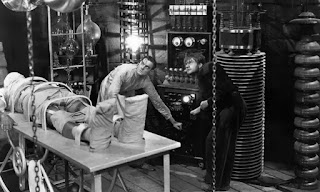This blog is a part of thinking activity. In which I'll be looking at the Mary Shelley's novel Frankenstein, through the lens of Cultural studies. For detailed infromation you can check Teachers Blog
Mary Shelley's Frankenstein has had a lasting impact on both high culture and popular entertainment, appearing in movies, TV shows, and even merchandise. Written during a time of social and political upheaval, the novel explores themes of science, politics, and gender roles. However, as it has become more commercialised, some argue that its original message of rebellion against authority has been diluted. The Creature in the story symbolises both the oppressed working class and the outsider, highlighting society’s mix of sympathy and fear toward marginalised groups. Even today, Frankenstein remains relevant, touching on our anxieties about technology and self-identity.
The Creature’s Paradoxical Nature
The Creature can be seen as a symbol of the lower classes or marginalised groups. Just like the Creature, these groups are often viewed sympathetically at first, as victims of an unfair system. However, when they rise up or demand change, they can be perceived as a threat. This shift from sympathy to fear is common in social movements, such as women’s rights or LGBTQ+ rights. These movements often begin by calling attention to real suffering and discrimination, which draws support.
This pattern is also seen in modern activism. When protesters use more radical tactics, such as disrupting everyday life, they are often labelled as extreme or dangerous, causing fear and resistance. A good example of this can be seen in the movie Ra.one.
Q. How does Shelley’s narrative engage with concepts of race and empire, and how might these issues be relevant today in global discourses on race and privilege?
Mary Shelley's Frankenstein engages deeply with themes of race and empire, exploring how society treats those who are seen as different or ‘Other’. The Creature, created by Victor Frankenstein, represents someone who doesn’t fit into society’s norms, either in appearance or behaviour. Because of this, he is viewed as a threat, a being defined by violence and revenge, not belonging to the accepted order of society.
From a postcolonial perspective, however, the Creature can be seen as innocent. He has little control over who he is or how he behaves, as he learns about the world from what he experiences. His creator, Victor, abandons him at his moment of need, much like how marginalised or oppressed communities are often abandoned by those in power. The Creature could be compared to colonised or enslaved peoples, such as African communities, who are physically strong but treated as ‘Other’, seen as different, feared, and oppressed.
Shelley's Frankenstein also addresses race and imperialism through the Creature's role as the ‘Other’. The Creature’s creation and rejection by Victor can be compared to the way European powers created colonies during imperialism, creating something they could control, then disclaiming it when it no longer served their interests.The Creature's abandonment reflects how imperial powers withdrew from their colonies, leaving them to deal with the consequences of poverty, conflict, and a crisis of identity. This story highlights how the legacy of colonialism continues to shape global power dynamics and perceptions of race and privilege.
Q. The Frankenstein in Popular Culture How have various retellings of Frankenstein reshaped its message for new audiences? How do these adaptations either retain or transform the novel’s original critique of scientific ambition and social exclusion?
The term ‘Frankenstein,’ coined by Timothy Morton, refers to how Mary Shelley's Frankenstein has been reinterpreted and reshaped across different forms of media and popular culture over the years.
Today, while some narratives still express concern about new technologies, many modern versions of the Frankenstein story have shifted. Instead of portraying the Creature as a mere threat, newer adaptations often make these creatures the protagonists, showing that scientific developments can be viewed as allies rather than enemies. Each adaptation of Frankenstein takes the original themes and reinterprets them to address the unique fears and issues of its time, from dangerous science to the potential dominance of technology over humanity.
I hope this would be helpful,
Thank you.







No comments:
Post a Comment